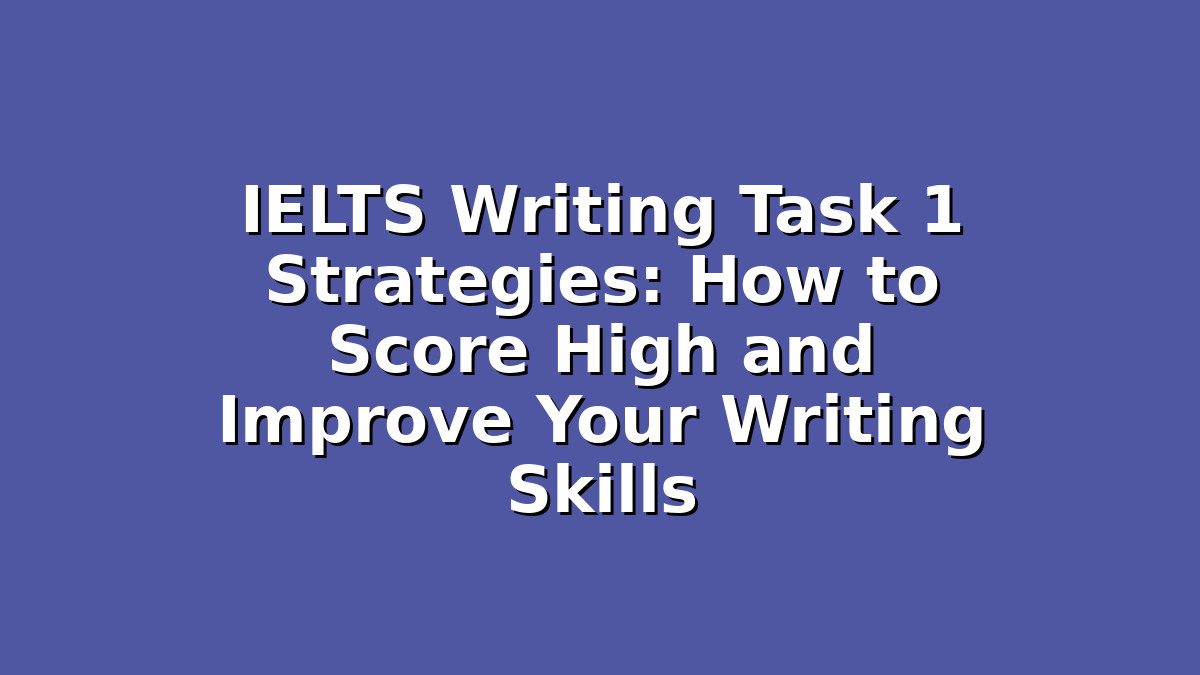Preparing for the IELTS exam can feel overwhelming, especially when it comes to the Writing section. Many students find IELTS Writing Task 1 challenging because it requires you to analyze and describe visual data quickly and accurately. However, with the right strategies and consistent practice, you can improve your writing skills and boost your score. In this article, we will explore effective IELTS Writing Task 1 strategies designed specifically for students preparing for exams. Whether you’re aiming for a band 7 or higher, these tips will help you approach the task confidently and efficiently.
Understanding IELTS Writing Task 1: The Basics
Before diving into strategies, it’s important to understand what IELTS Writing Task 1 entails. In this task, you are given a visual representation of information such as graphs, charts, tables, maps, or processes. Your goal is to write a clear summary or description of the key trends, comparisons, or stages presented in the visual data. You have 20 minutes to write at least 150 words.
The task assesses four key criteria: task achievement, coherence and cohesion, lexical resource, and grammatical range and accuracy. To excel, you need to present an overview, support your points with details, organize your ideas logically, use a variety of vocabulary, and avoid grammatical mistakes.
—
1. Analyze the Visual Data Thoroughly Before Writing
One of the most common mistakes students make is rushing to write without fully understanding the visual data. This can lead to incomplete or inaccurate descriptions, costing you valuable marks. Taking time to analyze the diagram or chart is crucial.
Tips for analyzing data effectively:
– Identify the type of visual: Is it a bar chart, line graph, pie chart, table, or process diagram? Each type requires a slightly different approach. For example, line graphs focus on trends over time, while pie charts involve proportions.
– Look for key trends and patterns: Notice where the data rises or falls, any striking differences, similarities, or exceptions. What stands out? Is there a general trend or notable fluctuations?
– Pay attention to units and time frames: Make sure you understand what the numbers represent (percentages, populations, currency) and the period covered.
– Note the main categories or groups: Who or what is being compared? Are there multiple variables?
By spending 3-5 minutes carefully analyzing the visual, you build a strong foundation for your writing. This step helps you avoid errors and ensures your description is accurate and focused on what matters most.
—
2. Structure Your Response Clearly and Coherently
A well-structured response is easy for examiners to follow and demonstrates your ability to organize information effectively. Most high-scoring IELTS Writing Task 1 answers follow a clear format: an introduction, an overview, and two or three body paragraphs with supporting details.
How to structure your answer:
– Introduction: Paraphrase the question prompt to introduce the visual data. Avoid copying the prompt word-for-word. For example, if the question asks you to describe a line graph showing unemployment rates, your introduction might be: “The line graph illustrates the changes in unemployment rates across four countries between 2000 and 2010.”
– Overview (Summary): This is your chance to highlight the main trends or significant features. Identify the most important data points or patterns without going into detail. Phrases like “Overall,” “It is clear that,” or “The most noticeable trend” work well here.
– Body paragraphs: Divide the data logically. You might group information by time periods, categories, or comparisons. Use specific data to support your points, mentioning figures, percentages, or years. Use linking words like “in contrast,” “similarly,” “while,” and “however” to connect ideas smoothly.
Example structure for a line graph:
– Introduction: Paraphrase the question.
– Overview: Summarize the general trends (increase, decrease, stability).
– Body 1: Describe the data for specific countries or categories showing increase.
– Body 2: Describe data for countries or categories with different patterns.
A clear structure not only improves coherence but also helps you manage your time during the exam.
—
3. Use a Range of Vocabulary and Grammar Accurately
Your lexical resource and grammatical range are critical scoring criteria in IELTS Writing Task 1. Using repetitive vocabulary or simple sentences can limit your band score. Instead, aim to vary your word choice and sentence structures while maintaining accuracy.
Vocabulary tips:
– Use synonyms for common verbs like “increase,” “decrease,” “rise,” and “fall.” For example, instead of repeatedly saying “increased,” use “rose,” “climbed,” “grew,” or “went up.”
– Learn and practice useful descriptive phrases for trends: “remained steady,” “fluctuated,” “peaked at,” “declined sharply,” “reached a plateau,” “experienced a gradual rise.”
– Use appropriate connectors to describe comparisons and contrasts: “whereas,” “while,” “in comparison to,” “on the other hand,” “similarly.”
Grammar tips:
– Use a mix of simple and complex sentences. Combine ideas with conjunctions such as “although,” “despite,” and “because.”
– Pay careful attention to tenses. Most graphs use past tense or present perfect if referring to data up to the present. For processes, use passive voice and present tense.
– Avoid common grammar mistakes like subject-verb agreement errors, incorrect prepositions, or missing articles.
Practice makes perfect: Regularly practice writing descriptions of different types of visuals and review model answers. Make a vocabulary notebook to record useful words and phrases. Time yourself to simulate exam conditions.
—
Conclusion
Mastering IELTS Writing Task 1 is achievable with the right approach and plenty of practice. Start by thoroughly analyzing the visual data to understand what you need to describe. Then, organize your response clearly with an introduction, overview, and detailed body paragraphs. Finally, enrich your writing by using a wide range of vocabulary and grammatical structures correctly. Remember, consistency is key—practice regularly, seek feedback, and build your confidence step by step. With these strategies, you’ll be well on your way to achieving a high band score in IELTS Writing Task 1.
Good luck, and keep writing!
—

Responses